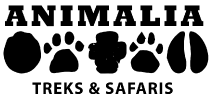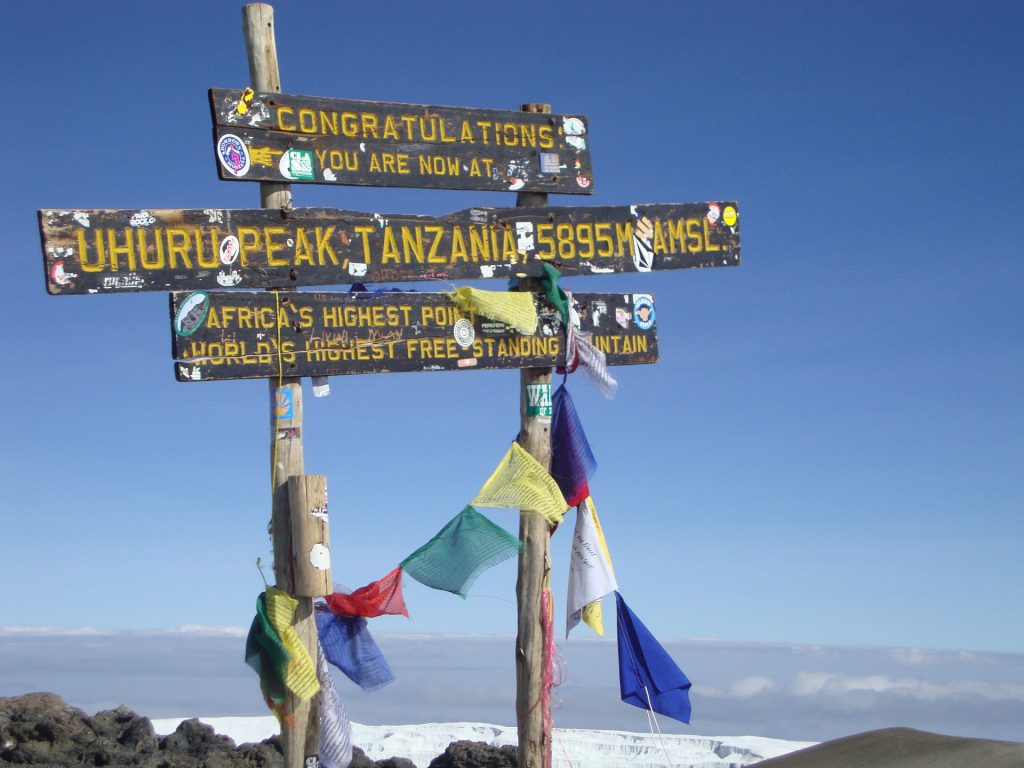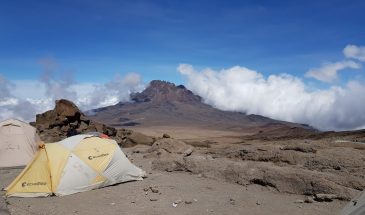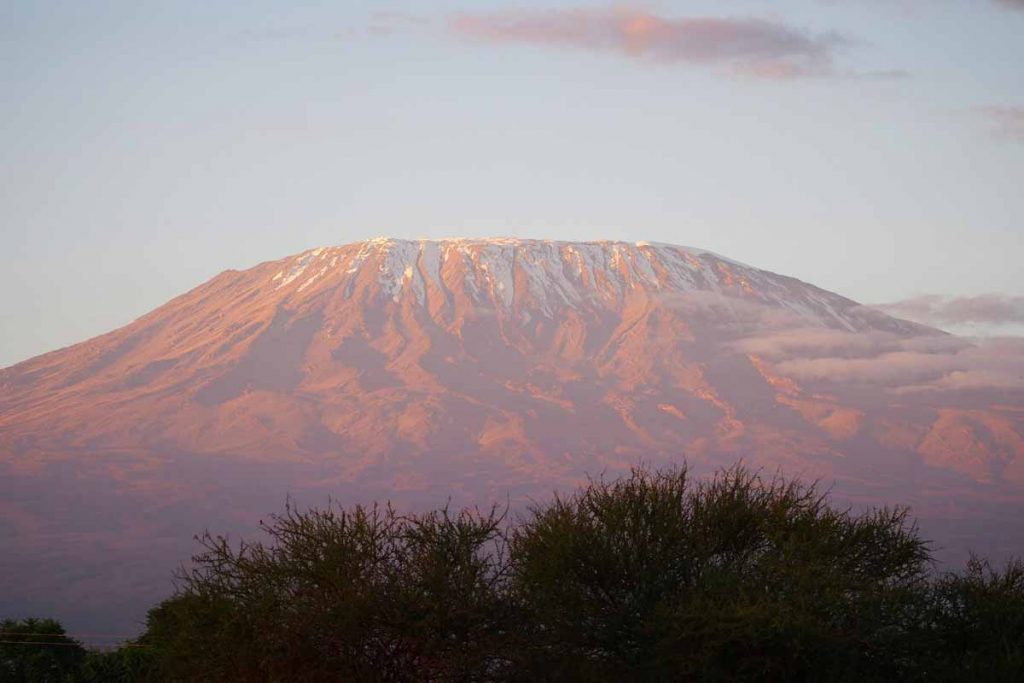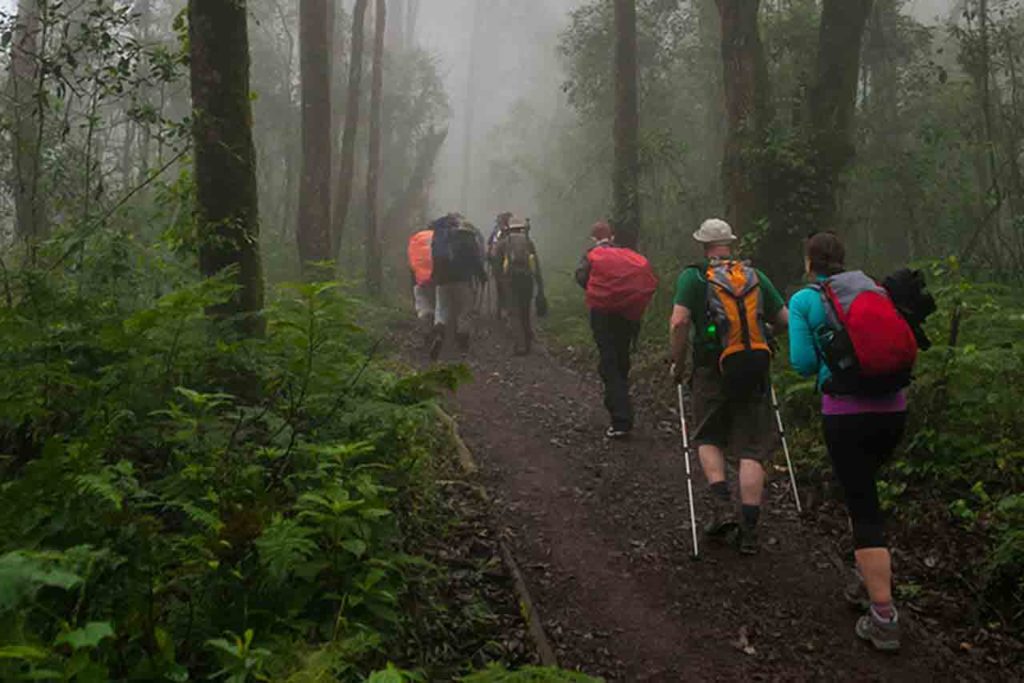- Overview
- Trip Outline
- Trip Includes
- Trip Excludes
- Gallery
- Booking
- FAQ
This tour also referred to as the whiskey route, is rightly regarded as the most beautiful on Kilimanjaro. It is particularly varied in landscape and offers great views of Mount Meru and the Kibo. Next to the Marangu route, it is the most popular route on the mountain. The varied height profile allows for good acclimatization, the number of summit successes is therefore high. However, the route is steeper and at the Barranco Wall, a simple climbing passage has to be overcome.
The route requires you to be in good condition and is less suitable for inexperienced mountain walkers than the Marangu route. Accommodation is at camping sites in tents. The descent is via the Mweka route.
The Machame route is recommended by us as a 7-day tour. This includes an additional acclimatization day, which significantly increases the success to reach the summit. For experienced and very fit mountain hikers, the 6-day tour is also suitable. The fourth day of the shortened tour walks directly from the Barranco Camp to the Barafu Camp, as the intermediate stage over the Karanga Camp is omitted.
The Machame route is also known as the Whiskey route, given its reputation for being a tough climb, in contrast to the easier Marangu route, which is known as the Coca Cola route. Unlike the gradual incline and hut accomodations found on the Marangu Route, the climbers on Machame hike steeper trails, for longer distances, while sleeping in tents.The Machame Route climb can be done in a minimum of six days (five nights) on the mountain.
However, it is most often tackled over seven days (six nights), for a better altitude acclimatization schedule. The trek begins at Machame Gate, located in the southern base of mountain, within its lush, fertile rainforest. The route heads toward the Shira Plateau, before circling along the southern circuit halfway around the mountain, exposing the climber to great views from all angles. The approach to the summit is made from the east, and the descent follows the Mweka trail.
Itineraries
Arrival
Arrive in Tanzania
You will be picked up at the Kilimanjaro International Airport and transferred to your hotel in Moshi town; you will meet your guide who will brief you on your upcoming trek and do an equipment check to make sure you have all the necessary mountain gear. The missing gear can be rented on this day.
Overnight: at your Hotel in Moshi
Meals: Bed & Breakfast
Day 1
Machame Gate (1790m) to Machame Camp (3010m)
One hour’s drive from Moshi to Machame gate, where we complete park formalities, meet our crew of porters and start to climb! The first section of the route climbs steadily and passes through magnificent, dense rainforest. This path is less well-trodden so it can get somewhat overgrown in places and it is often wet and muddy underfoot.
Distance: 11 km Hiking
Time: 5-7 hours
Meals: Breakfast, Lunch and Dinner Included.
Day 2
Machame Camp (3010m) to Shira Camp (3845m)
Our route continues on up through the forest until we reach the steep ascent onto the Shira Plateau, where there are rewarding views of the mountain. Looking back, you will be able to see Mt Meru rising high above Arusha town in the distance.
Distance: 5 km Hiking
Time: 5 hours
Meals: Breakfast, Lunch and Dinner Included.
Day 3
Shira Cave (3845m) to Barranco Camp (3960m)
Walking now on high moorland, the landscape changes the entire character of the trek. We traverse the southwest side of Kilimanjaro, passing underneath the Lava Tower and the final section of the Western Breach and finally reach camp The day has been spent at altitude (up to 4600m), but we have followed the mountaineering code of ‘walk high, sleep low’ to aid your body’s acclimatization to altitude.
Distance: 10.8 km Hiking
Time: 8 hours
Meals: Breakfast, Lunch and Dinner Included.
Day 4
Barranco Camp (3960m) to Karanga Camp (3963m)
Our day starts by descending into the start of the Great Barranco, a huge ravine. We then exit steeply, up the Great Barranco Wall, which divides us from the southeastern slopes of Kibo. It’s a climb over rock, not technical but long and tiring. Passing underneath the Heim and Kersten glaciers, we head towards the Karanga valley. From here we have a steep climb up from Karanga valley to our night’s camp at Karanga camp, set at 3963m. For those feeling strong we will go for a mid-afternoon acclimatization trek up to around 4200m before descending back to camp for the night.
Distance: 5.5 km Hiking
Time: 5 hours
Meals: Breakfast, Lunch and Dinner Included.
Day 5
Karanga Camp (3963) to Barafu Camp (4640m)
After a good night’s rest and breakfast, we set off on our walk to Barafu camp at 4640m. The climb will take us across desolate scree slopes with no vegetation around us at all. It’s a tough steep walk made more difficult by the altitude. On arriving at camp we eat and spend the afternoon resting as we prepare for a long night and day ahead. It is important to keep hydrated and warm. We have an early dinner and then try to get some sleep as we will be getting up at between 11pm and 12pm to start the climb to the summit.
Distance: 3 km Hiking
Time: 3 hours
Meals: Breakfast, Lunch and Dinner Included.
Day 6
Barafu Camp (4640m) to Uhuru Peak (5895m) & down to Millennium Camp (3790m)
We start off at around midnight, and walk steeply upwards to the summit glaciers. We will be climbing scree for 4 to 5 hours but gain incredible height over a short distance. The views are spectacular. We should be on the crater rim at Stella Point (5739m) as the first rays of the sun hit us. Spectacular ice cliffs within the crater surround us and the views to jagged Mawenzi peak and beyond are breathtaking. Another hour’s walking takes us to the summit, Uhuru Peak (5895m). We begin our descent by returning to Stella Point and then descending on scree slope and track back to Barafu Camp for breakfast, before finally heading down to Millennium Camp for a long well-earned rest.
Distance: 5 km ascent / 12 km descent
Time: 7-8 hours ascent / 4-6 hours descent
Meals: Breakfast, Lunch and Dinner Included.
Day 7
Trek Millennium Camp (3790m) to Mweka Gate (1630m)
A gentle trek takes us down through the rain forest to Mweka Gate, where we complete park formalities and receive certificates, which you can hang up with pride! We are then met by our vehicles and return to the hotel in Moshi, where you can treat yourself to a welcome hot shower.
Distance: 12 km Hiking
Time: 6 hours
Meals: Breakfast, Lunch and Dinner Included.
Departure
Depart Tanzania
The day is left free to wind down after the trek before your flight home. Depending on flight times you could go and explore Moshi town and grab some gifts shop before heading to the airport.
- Private transport to & from Kilimanjaro International Airport to your accommodations in Moshi.
- Transportation to & from the Kilimanjaro gate.
- Park entry fees,
- Camping fees.
- Team Kilimanjaro Rescue fees.
- Friendly and professional mountain guides, cook, and porters.
- Accommodations
- Professional Mountain guide
- Enough treated & filtered drinking water throughout the trek.
- Hot water for washing.
- Government taxes.
- Emergency first-aid kit
- 18% VAT on tour fees & services.
- Mountain tents.
- All meals on the mountain (breakfast, lunch & dinner)
- Fair wages for the mountain crew as approved by the Kilimanjaro National Park Authority (KINAPA), and the Kilimanjaro Association of Tour Operators (KIATO).
- Meals and drinks not specified
- Mountain equipment (eg sleeping bags)
- Gear for your climb, Some equipment is available for rent!
- Items of personal nature (expenses)
- Emergency Oxygen
- Additional nights beyond the two standard hotel nights included
- Extra activities (waterfall tour, cultural village visit).
- Visa fees & travel insurance.
- Flight tickets.
- Tips for guides, porters, and cooks (this is a guide to tipping on the mountain http://www.kiliporters.org/tipping_recommendations.php
The best time to climb Kilimanjaro is during the dry season, i.e., from June to early November and from December to end of March. However with changing weather patterns, the chances of getting a clear sky during your climb in November and April is rare.
Yes we do have a kit list of all the items you will require for your climb. You can rent sleeping bags, parkas, gaiters, trekking poles, etc. Just e-mail us your list of needs, and we will reserve these items for provide you upon your arrival.
Anybody who are able to run for at least half an hour without feeling shortness of breath. You should also be able to walk for at least 2 hours in hilly terrains without feeling overly exhausted. No one with a sore throat, cold of breathing problems should go beyond 3000m. However, anybody with heart or lung problems should consult his/her physician before attempting to climb Mt Kilimanjaro.
No, you are not required to bring filtering systems or purification tablets, our climbing staff will provide you with plenty of purified drinking water during your trek.
The climb to Kilimanjaro is not a technical climb. No mountaineering equipment is require to summit Kilimanjaro. Anyone in good physical condition can reach the top of Mount Kilimanjaro.
Yes. The price also contains the salary of a porter, who is assigned to carry the oxygen tanks during your summit attempt.
Our mountain crews are in constant radio communication with us via ICOM radios so if anything goes wrong on your trekking we are informed. Also, the cell reception on the mountain has improved so we can effectively communicate with our teams using mobile phones.
The symptoms of altitude sickness can appear while climbing Mt. Kilimanjaro, in all climbers irrespective of their age and/or fitness level. Due to which, most climbers choose to use Diamox (Acetazolamide), a medication that diminishes headache, tiredness, nausea, dizziness, and shortness of breath which occur when climbing to high altitudes. Side effects include a tingling sensation in fingertips and on the face, and frequent urination.

